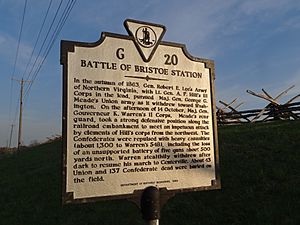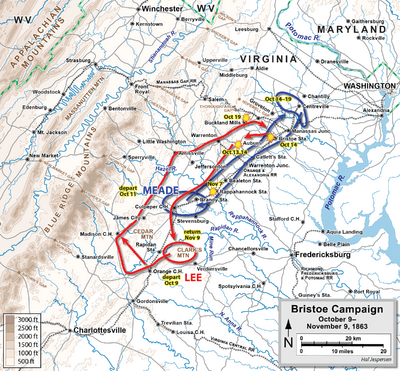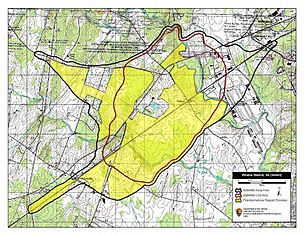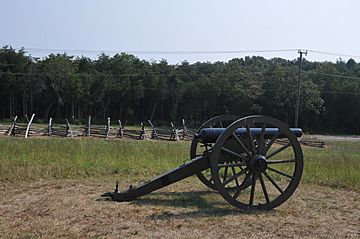Battle of Bristoe Station facts for kids
Quick facts for kids Battle of Bristoe Station |
|||||||
|---|---|---|---|---|---|---|---|
| Part of the American Civil War | |||||||
 Bristoe Station |
|||||||
|
|||||||
| Belligerents | |||||||
| Commanders and leaders | |||||||
| Gouverneur K. Warren | A. P. Hill | ||||||
| Units involved | |||||||
| II Corps, Army of the Potomac | Third Corps, Army of Northern Virginia | ||||||
| Strength | |||||||
| 8,383 | 17,218 | ||||||
| Casualties and losses | |||||||
| 540 | 1,380 | ||||||
The Battle of Bristoe Station was a fight during the American Civil War on October 14, 1863. It happened in Bristoe Station, Virginia. In this battle, soldiers from the Union (the North) led by Gouverneur K. Warren fought against Confederate (the South) soldiers led by A. P. Hill. General Warren's Union troops managed to surprise and push back the Confederates. This led to a victory for the Union side.
Contents
Why Did the Battle of Bristoe Station Happen?
The American Civil War was a big conflict between the Northern states (the Union) and the Southern states (the Confederacy). In 1863, both armies were moving around Virginia. The Union army was led by General George Meade. The Confederate army was led by General Robert E. Lee.
General Lee tried to outsmart General Meade. He moved his army around a place called Cedar Mountain. This forced Meade's Union army to retreat towards Centreville. By pulling back, Meade kept his army safe from a surprise attack.
The Union Retreat and Skirmishes
During this retreat, the Union II Corps was led by General Gouverneur K. Warren. He was following another Union group, the V Corps. On October 13, Warren's troops had a small fight with Confederate cavalry (soldiers on horseback) led by General J. E. B. Stuart. This fight was near Auburn, Virginia, and was called the First Battle of Auburn. Soldiers even nicknamed it "Coffee Hill" because Confederate shells interrupted them while they were making coffee!
Warren's job was tough. He had to push Stuart's cavalry away. At the same time, he needed to keep retreating from another Confederate group. This group was led by General Richard S. Ewell.
On October 14, as Warren's troops moved towards Bristoe Station, Stuart's cavalry bothered their rear guard again. This was called the Second Battle of Auburn.
Confederate Advance and Union Ambush
Meanwhile, General A. P. Hill was leading another Confederate group, the Third Corps. He was moving on the left side of General Ewell's army. Hill reached Bristoe Station on October 14.
General Hill tried to attack the rear of the Union V Corps. But he didn't realize that Warren's II Corps was just arriving from Auburn. Warren quickly saw what was happening. He quickly set up his soldiers behind a railroad embankment near Bristoe Station. This was a perfect spot for an ambush. As Hill's Confederate troops moved to attack, they walked right into Warren's trap.
The Battle at Bristoe Station
General Henry Heth's Confederate division was supposed to attack the Union V Corps. But they were redirected to attack Warren's II Corps instead. Union cannons, including those led by Captain R. Bruce Ricketts, immediately started firing at the Confederates. Soon, Union infantry (foot soldiers) also joined in.
Despite the heavy fire, Heth's men briefly managed to get into the Union lines. This happened in the area defended by Colonel James E. Mallon. But the Confederates were quickly pushed back. In a Union counterattack, five Confederate cannons were captured! Sadly, Colonel Mallon was killed during this fighting.
Another Confederate division, led by General Richard H. Anderson, also attacked. They charged the lines of General Alexander Hays's division. But they were also pushed back. General Carnot Posey was badly wounded in this attack and later died. Two of General Heth's brigade commanders, William Whedbee Kirkland and John Rogers Cooke, were also seriously wounded.
What Happened After the Battle?
The Union army had about 540 soldiers killed or wounded. The Confederate army had about 1,380 casualties. Even though the Union won, General Warren eventually had to pull back. He saw General Richard S. Ewell's Confederate Second Corps coming up on his left side.
General Lee was very unhappy about this defeat. He reportedly told General Hill, "Well, well, general, bury these poor men and let us say no more about it." The Union forces won the battle, but they still had to retreat to Centreville, Virginia. They finally stood their ground there.
When the Union army pulled back again starting on October 18, the Confederates destroyed much of the Orange and Alexandria Railroad. General Meade then had to rebuild the railroad when his army moved back into the Bristoe Station area. General Warren gained a great reputation after this battle. He was later given command of the V Corps permanently.
Protecting the Battlefield
Today, groups like the American Battlefield Trust work to save historic battlefields. They and their partners have bought and protected about 286 acres of the Bristoe Station battlefield.
However, some parts of the battlefield are still at risk. The Prince William County Board of Supervisors approved building houses on about 1,500 acres where the battle took place. A company called Centex Homes gave the Civil War Trust 90 days to find and move any human remains before they started building homes.
Images for kids








